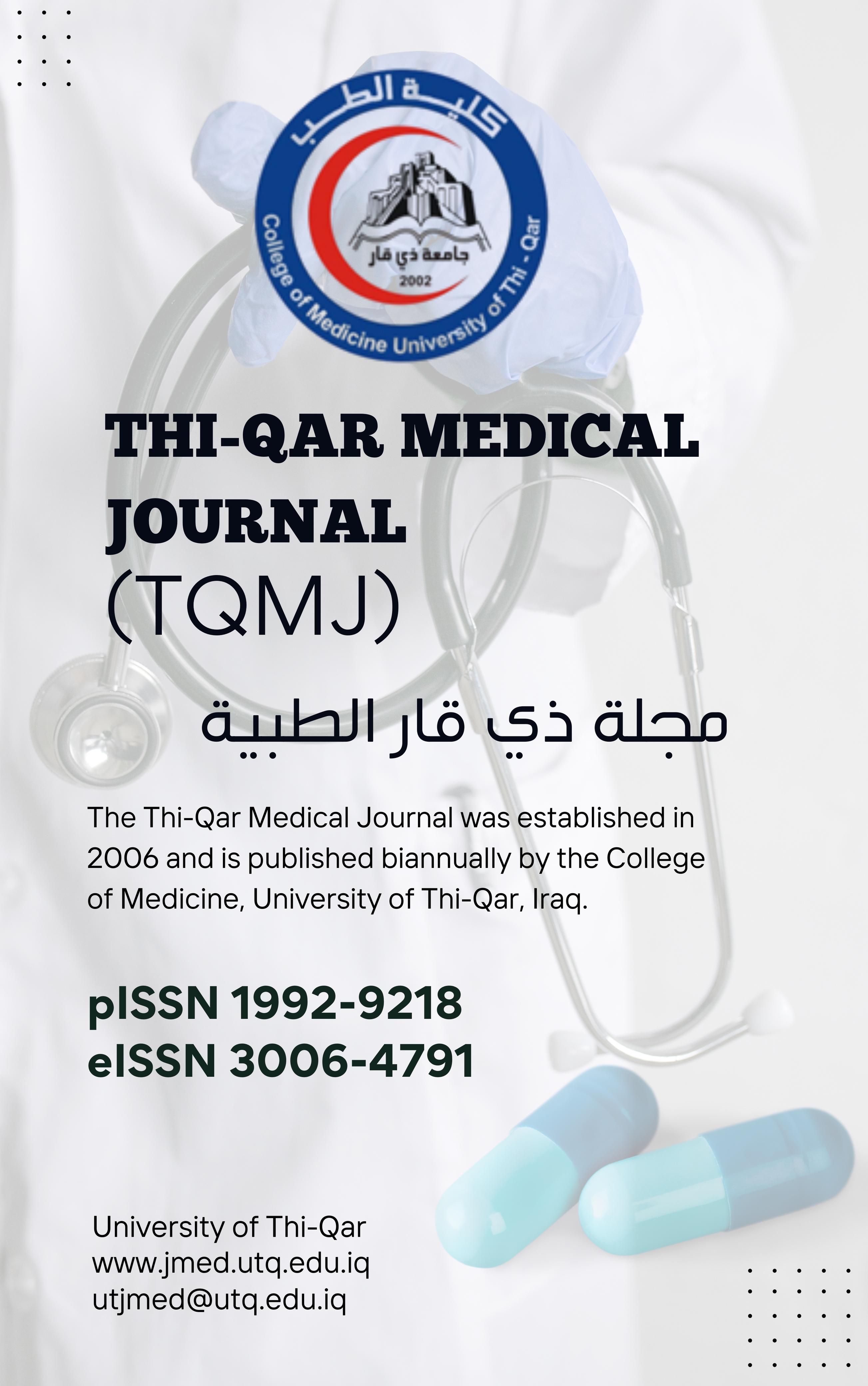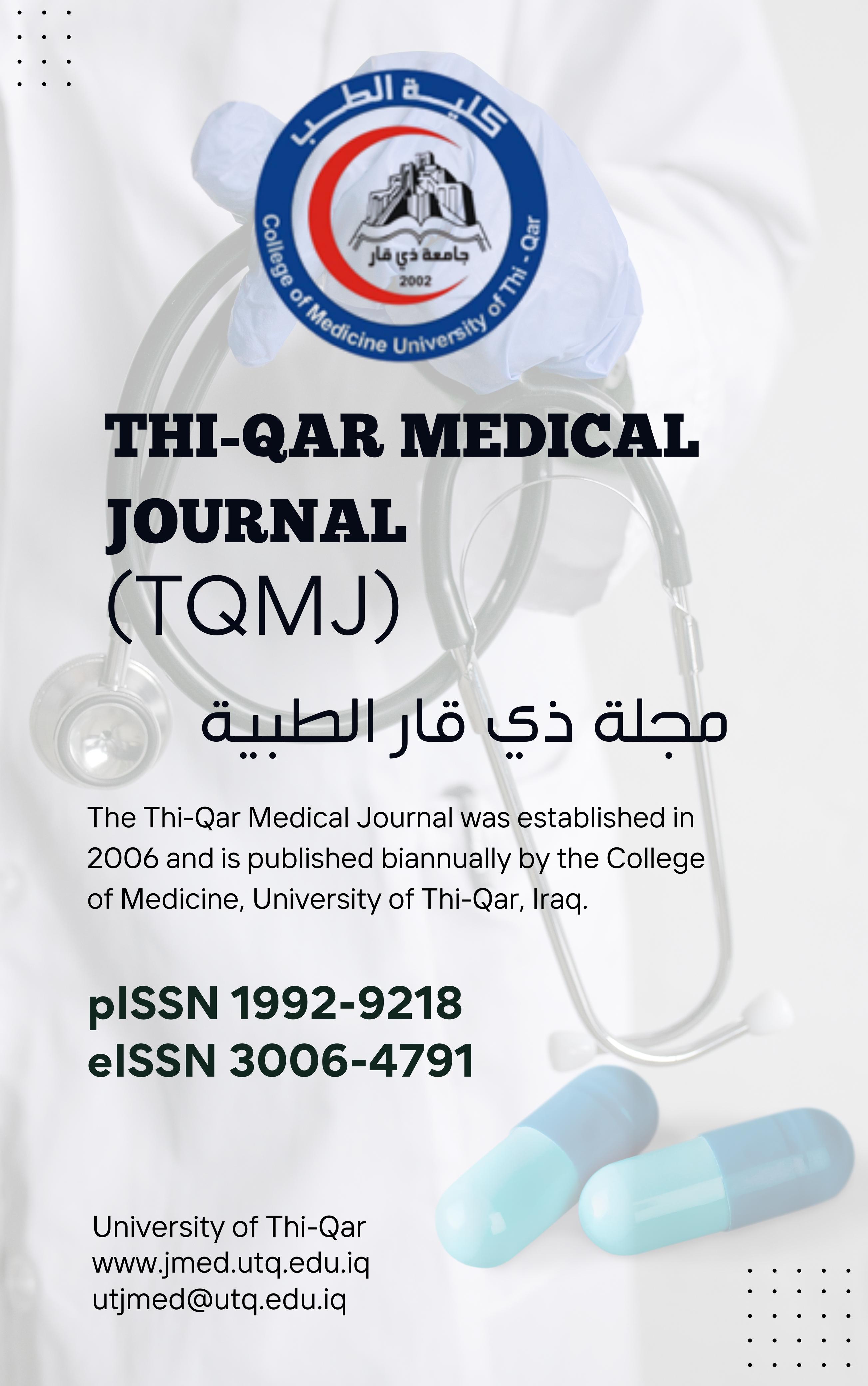Assessment of renal tubular impairment in beta-thalassemia major patients by using a novel biomarker
DOI:
https://doi.org/10.32792/jmed.2025.29.6%20Keywords:
Thalassemia, tubular dysfunction, NGAL, ACRAbstract
Thalassemia is a group of hereditary blood disorders caused by genemutations. Beta-thalassemia major is a more severe type because the
individuals require blood transfusions for survival. The renal tubular
disorder is caused by anemia, iron overload and receiving specific iron
chelators, which all of them can lead to renal tubular impairment. The
aim of case control study was to assess the role of serum NGAL as an
early marker for the diagnosis of tubular dysfunction in BTM patients.
Also to investigate the effect of iron chelator on tubular function. The
study includes 60 beta-TM patients. The control group includes 30
healthy individuals. Patients were divided into 2 groups: group A treated
with Deferoxamine (DFO) and group B treated with Deferasirox (DFX).
Blood iron, Serum NGAL and albumin/creatinine ratio (ACR) in urine
were measured in patients and controls. Patients in the study had higher
Albumin-Creatinine Ratio (ACR) values than controls, which is
statistically significant. S.NGAL shows a statistically significant
difference between the patients and control group.Urinary ACR and
serum NGAL are considered an early marker of renal tubular dysfunction
in BTM. Both Deferasirox and Deferoxamine produce changes in the
tubular function.
References
Shafique F, Ali S, Almansouri T, Van F, Shafi N, Khalid M, et al. Thalassemia: a human blood disorder.
Brazilian Journal of Biology. 2023; 83:e246062. DOI: 10.1590/1519-6984.246062 .
Ali S, Mumtaz S, Shakir HA, Khan M, Tahir HM, Mumtaz S, et al. Current status of beta-thalassemia and its
treatment strategies. Molecular Genetics & Genomic Medicine. 2021; 9(12):e1788. DOI: 10.1002/mgg3.1788 .
Shaalan MG, Hassan MK, Al-Shanoof HJ, Al Naama LM. Renal dysfunction in pediatric patients in Iraq with β
thalassemia major and intermedia. Cureus. 2022; 14(9):e29183. DOI: 10.7759/cureus.29183 .
Benoit SW, Ciccia EA, Devarajan P. Cystatin C as a biomarker of chronic kidney disease: latest developments.
Expert Review of Molecular Diagnostics. 2020; 20(10):19–26. DOI: 10.1080/14737159.2020.1783233 .
Demosthenous C, Vlachaki E, Apostolou C, Eleftheriou P, Kotsiafti A, Vetsiou E, et al. Beta-thalassemia: renal
complications and mechanisms: a narrative review. Hematology. 2019; 24(1):426–438. DOI:
1080/16078454.2019.1599096 .
Arman O, Kirkiz S, Fettah A, Ok Bozkaya I, Kara A, Çakar N, Yaralı N. Renal function and the oxidative status
among children with thalassemia major and healthy controls: a cross-sectional study. Transfusion and Apheresis
Science. 2020; 59(4):102748. DOI: 10.1016/j.transci.2020.102748 .
Hashemieh M. Early detection of renal dysfunction in β-thalassemia with focus on novel biomarkers. Iranian
Journal of Pediatric Hematology and Oncology. 2020; 10(1):57–68. DOI: 10.30699/ijpho.10.1.57 .
Mahmoud AA, Elian DM, Abd El Hady NMS, Abdallah HM, Abdelsattar S, Khalil FO, et al. Assessment of
subclinical renal glomerular and tubular dysfunction in children with beta-thalassemia major. Children. 2021;
(2):100. DOI: 10.3390/children8020100 .
Ige AO, Ongele FA, Adele BO, Emediong IE, Odetola AO, Adewoye EO. Pathophysiology of iron overload
induced renal injury and dysfunction: roles of renal oxidative stress and systemic inflammatory mediators.
Pathophysiology. 2019; 26(2):175–180. DOI: 10.1016/j.pathophys.2019.01.001 .
Entezari S, Haghi SM, Norouzkhani N, Sahebnazar B, Vosoughian F, Akbarzadeh D, et al. Iron chelators in
treatment of iron overload. Journal of Toxicology. 2022; 2022:4911205. DOI: 10.1155/2022/4911205.
Sarbay H, Akbalık Kara M. The Effect of Deferasirox Dose and Treatment Duration on Frequency of Proteinuria
and Renal Functions in Patients with Thalassemia Major. Cyprus Journal of Medical Sciences. 2023; 7(6):801–805 .
(DOI not available)
Schrezenmeier EV, Barasch J, Budde K, Westhoff T, Schmidt-Ott KM. Biomarkers in acute kidney injury –
pathophysiological basis and clinical performance. Acta Physiologica (Oxf). 2017; 219(3):554–572. DOI:
1111/apha.12764 .
Castillo E, Fernandez R, Martin C, Pizarro S, Sanchez D, et al. Kidney Injury Marker 1 and Neutrophil
Gelatinase-Associated Lipocalin in Chronic Kidney Disease. Nephron. 2017; 136(4):263–267 .(DOI not available)
Haider MZ, Aslam A. Proteinuria. [Updated 2023 Sep 4]. In: StatPearls [Internet]. Treasure Island (FL):
StatPearls Publishing; 2024 Jan–. Available from: https://www.ncbi.nlm.nih.gov/books/NBK564390 /(DOI not
available)
Bhandari J, Thada PK, Rout P, et al. Tubulointerstitial Nephritis. [Updated 2024 May 19]. In: StatPearls
[Internet]. Treasure Island (FL): StatPearls Publishing; 2024 Jan–. Available from:
https://www.ncbi.nlm.nih.gov/books/NBK557537 /(DOI not available)
Bokenkamp A. Proteinuria—takes a closer look. Pediatric Nephrology. 2020; 35(4):533–541. DOI:
1007/s00467-019-04454-w .
Sen V, Ece A, Uluca U, Soker M, Gunes A, Kaplan I, et al. Urinary early kidney injury molecules in children
with beta-thalassemia major. Renal Failure. 2015; 37(4):607–613. DOI: 10.3109/0886022X.2015.1007871 .
El-Hawy MA, Allam ET, Abd H, Shashin E aziz M, El-Haroun MS. Urinary biomarkers of early kidney injury
in children with beta-thalassemia. Pediatric Hematology/Oncology and Immunopathology. 2023; 22(4):90–95. DOI:
24287/1726-1708-2023-22-4-90-95 .
Arian M, Oghazian MB, Noureldine MHA, et al. Biochemical Markers of Early Renal Dysfunction in Patients
with β-thalassemia Major: A Systematic Review and Meta-analysis. Current Medicinal Chemistry. 2023. DOI:
2174/0929867330666230623140205 .
Abd M, Mostafa E, Hesham MA, Khalifa NA, Beshir MR. Evaluation of Novel Biomarkers for Early Detection
of Acute Kidney Injury in Children with B-Thalassemia Major. Zagazig University Medical Journal. 2024;
(4):2282–2288 .(DOI not available)
Tammadondar M, Vatankhah A, Khatibzade-nasari N. Assessment of the Correlation Between Renal Function
Markers and Serum Ferritin Levels in Thalassemia Patients. International Journal of Clinical Practice. 2025;
:6915906. DOI: 10.1155/ijcp/6915906 .
Kamel AS, Mansour IAE Sattar, Mohamed EA. Serum cystatin C versus urinary albumin creatinine ratio as an
early indicator of kidney dysfunction in children affected by beta thalassemia major. Al-Azhar Journal of Pediatrics.
; 25(1):2428–2441 .(DOI not available)
Mahmoud AA, Elian D. Serum Neutrophil gelatinase-associated lipocalin in children with beta thalassemia
major as a promising marker for predicting renal tubular impairment. Pediatric Hematology/Oncology and
Immunopathology. 2024; 23(4):107–111 .(DOI not available)
Mohammed M, Mohammad J, Fathi Z, Al-Hamdany M, Alkazzaz N. Comparative evaluation of cystatin C and
neutrophil gelatinase-associated lipocalin in patients with thalassemia major versus thalassemia intermedia.
Pharmacia. 2021 Oct 4; 68(4):741–746 .(DOI not available)
Romadhon PZ, Ashariati A, Bintoro SUY, Thaha M, Suryantoro SD, Windradi C, et al. Markers of Renal
Complications in Beta Thalassemia Patients with Iron Overload Receiving Chelation Agent Therapy: A Systematic
Review. Journal of Blood Medicine. 2022 Nov 28; 13:725–738 .(DOI not available)
Tanous O, Azulay Y, Halevy R, et al. Renal function in β-thalassemia major patients treated with two different
iron-chelation regimes. BMC Nephrology. 2021; 22:11 .(DOI not available)
Badeli H, Baghersalimi A, Eslami S, et al. Early Kidney Damage Markers after Deferasirox Treatment in
Patients with Thalassemia Major: A Case-Control Study. Oxidative Medicine and Cellular Longevity. 2019; 2019:8 .
(DOI not available)
Zeid MY, Hassab HM, Younan DN, et al. Study of the effect of different iron-chelating agents on early renal
glomerular and tubular function markers in children with beta thalassemia. Alexandria Journal of Pediatrics. 2020;
–123. (DOI not available)
Downloads
Published
Issue
Section
License
Copyright (c) 2025 Younis Hassan Mohammed ALI, Hashim Abdulsttar Jabar

This work is licensed under a Creative Commons Attribution 4.0 International License.





